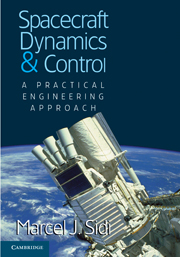Book contents
- Frontmatter
- Dedication
- Contents
- Preface
- Acknowledgments
- Chapter 1 Introduction
- Chapter 2 Orbit Dynamics
- Chapter 3 Orbital Maneuvers
- Chapter 4 Attitude Dynamics and Kinematics
- Chapter 5 Gravity Gradient Stabilization
- Chapter 6 Single- and Dual-Spin Stabilization
- Chapter 7 Attitude Maneuvers in Space
- Chapter 8 Momentum-Biased Attitude Stabilization
- Chapter 9 Reaction Thruster Attitude Control
- Chapter 10 Structural Dynamics and Liquid Sloshing
- Appendix A Attitude Transformations in Space
- Appendix B Attitude Determination Hardware
- Appendix C Orbit and Attitude Control Hardware
- Index
- References
Appendix B - Attitude Determination Hardware
Published online by Cambridge University Press: 18 December 2014
- Frontmatter
- Dedication
- Contents
- Preface
- Acknowledgments
- Chapter 1 Introduction
- Chapter 2 Orbit Dynamics
- Chapter 3 Orbital Maneuvers
- Chapter 4 Attitude Dynamics and Kinematics
- Chapter 5 Gravity Gradient Stabilization
- Chapter 6 Single- and Dual-Spin Stabilization
- Chapter 7 Attitude Maneuvers in Space
- Chapter 8 Momentum-Biased Attitude Stabilization
- Chapter 9 Reaction Thruster Attitude Control
- Chapter 10 Structural Dynamics and Liquid Sloshing
- Appendix A Attitude Transformations in Space
- Appendix B Attitude Determination Hardware
- Appendix C Orbit and Attitude Control Hardware
- Index
- References
Summary
Introduction
Hardware items that are mandatory for realizing almost any spacecraft attitude and orbit control system can be divided into two classes: instrumentation for measuring the attitude of the satellite; and instrumentation for providing forces and torques. The latter category will be treated in Appendix C. Appendix B deals with attitude sensors, but is not an extensive treatment of the subject. There are excellent textbooks and technical papers providing complete treatment of the hardware from both analytical and practical points of view; Wertz (1978) is especially recommended. However, for completeness and for the reader's convenience, a short exposition of the basic principles of satellite attitude hardware will be presented here, together with examples of existing space-proven commercial instruments.
Attitude measurement hardware is used to determine the attitude of the satellite with respect to a defined reference frame. The final product may be, for instance, the Euler angles of the satellite in the orbit reference frame, or (in a different context) the sun vector components in the body axis frame. Attitude determination hardware includes:
earth sensors (in particular, infrared earth sensors);
sun sensors;
star sensors;
rate and rate integrating sensors, based on gyroscopic, laser, or other solid-state principles; and
magnetometers.
The quality of the instruments is responsible for the accuracy that can be achieved in the attitude control system. For instance, there are sun sensors that can measure the direction of the sun with an accuracy of 0.015°, whereas others have an accuracy of only 0.5° however, analytical processing of the two sensors° output is basically the same. The commonly used attitude reference sources are the earth, the sun, and the stars.
The earth is used in two different aspects, optical and magnetic. The more important one is the optical aspect. Unlike the sun (which appears as a small illuminated disk) or the stars (which can be treated as illuminated points), the earth – as seen from nearby space – has a complex appearance that must be adequately modeled for accurate attitude determination.
Information
- Type
- Chapter
- Information
- Spacecraft Dynamics and ControlA Practical Engineering Approach, pp. 328 - 378Publisher: Cambridge University PressPrint publication year: 1997
